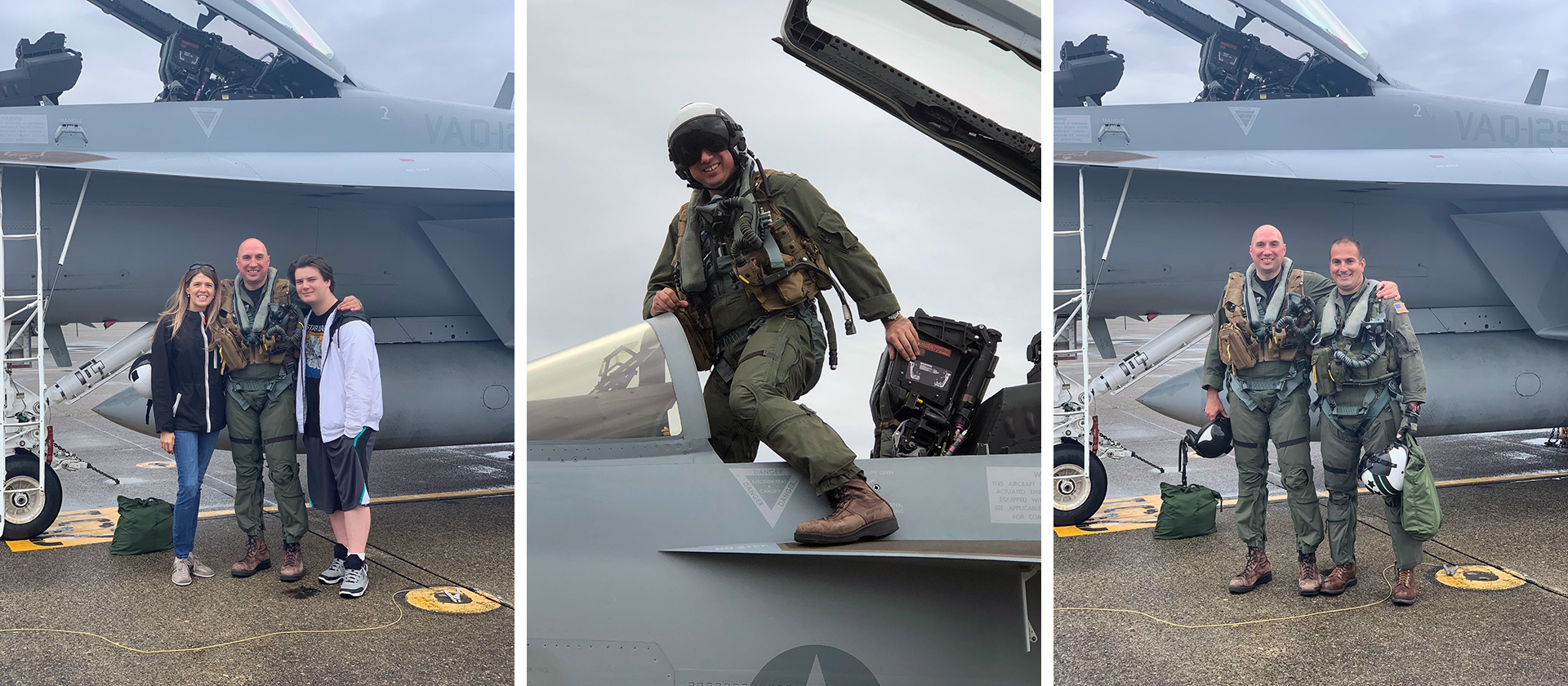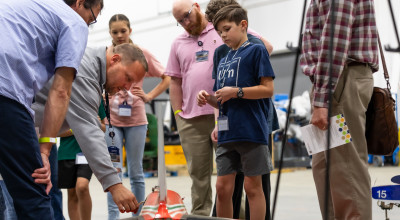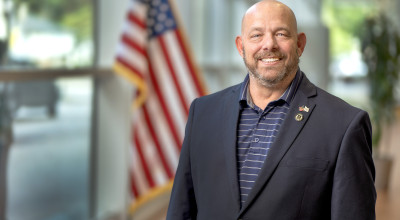For GTRI Senior Research Scientist David "Pearl" Picinich, the debut of "Top Gun: Maverick" marks a nostalgic close to an action-packed chapter in his life story.
Picinich, who retired from the U.S. Navy in 2019 as a naval aviator, put his flight skills to use in the long-awaited sequel to the 1986 action drama "Top Gun," where he scouted out flight scenes for the film crew, and trained and flew with some of the pilots and actors who flew the iconic planes in the movie.
Though Picinich has family members who served in the military – including uncles who served in the Vietnam War and a brother who is a current naval aviator – he said the original "Top Gun" film sparked his initial interest in flying for the Navy.
"I'll never forget it – I was in the sixth grade when I saw the first 'Top Gun,'" Picinich said. "After seeing the movie, I wrote to the Navy expressing my interest in flying, and received an information packet about aviation from the U.S. Naval Test Pilot School in Maryland."
Picinich went on to attend the U.S. Naval Academy, where he was a member of the offshore sailing team. Picinich said he chose the Naval Academy because he considered it to be "one of the most direct paths to a career in naval aviation." After graduating from the Naval Academy, Picinich attended flight school in Pensacola, Fla.; Corpus Christi, Texas; and Meridian, Miss. Following flight school, Picinich served as an EA-6B Prowler and EA-18G Growler pilot.

Left: David Picinich (center) with his fiancé and son in 2019. Center: David Picinich was pictured in 2019 taking one last flight in an EA-18G Growler before retiring from the Navy. Right: David Picinich (left) stands with Brian Arena, the former commanding officer of the U.S. Navy's Electronic Attack Squadron 209, which hosted the "Top Gun" film crew, actors, and dedicated F/A-18E/F photo aircraft, and whose aircrew and aircraft flew in direct support of the aerial filming. Photo credit: David Picinich.
Picinich graduated from the Electronic Attack Weapons School and completed the full F/A-18E/F Super Hornet flight training syllabus in preparation for his role as one of the initial cadre in the Airborne Electronic Attack community’s transition from the EA-6B to the EA-18G. Picinich joined GTRI in 2020 and currently works in the Sensors and Electromagnetic Applications Laboratory (SEAL), where he conducts electronic warfare research for the Navy.
Picinich was first approached by the "Top Gun" film crew through official Navy channels in 2018.
"They were looking for mountainous scenes to do low-altitude flying for the mission part of the movie," Picinich said. "One of the best low-altitude areas in the United States is in the Cascade Mountains near Whidbey Island in Washington where Growlers are flown, so I helped scout out that area for the director and film crew."
Picinich at the time was stationed at Naval Air Station Whidbey Island, where he was serving as the Director of Operations for the Electronic Attack Wing, U.S. Pacific Fleet.
The movie follows the return of Tom Cruise's character, Pete "Maverick" Mitchell, to the United States Navy Fighter Weapons School, popularly known as TOPGUN, to train an elite group of F/A-18E/F Super Hornet aviators for an urgent mission. The mission is to destroy the uranium enrichment facility of an unnamed rogue nation.
While flying on his regular training routes, Picinich attached two GoPro cameras provided by the film crew on the left- and right-hand side of his aircraft canopy. The GoPros recorded the mountainous terrain and Picinich shared the footage with the film’s supervising location manager, Mike Fantasia.
Timecode: 1:28:00 - 5:31:00 Merged GoPro footage shot from the left- and right-hand side of David Picinich's aircraft canopy on a flight route in the Cascade Mountains near Whidbey Island, Wash., where the final mission in "Top Gun: Maverick" was filmed.
"I would basically take cameras on my training route and film," Picinich explained. "I would film with one GoPro suctioned to the left-hand side of the canopy and one attached to the right-hand side to get as wide of a view as possible. The director and film crew would review the footage and pick out spots for certain movie scenes."
Picinich noted that none of the actors who portrayed the TOPGUN graduates – including Bradley "Rooster" Bradshaw, the son of Mitchell's late best friend Nick "Goose" Bradshaw – actually piloted the aircraft in the movie. Instead, cameras filmed the actors sitting in the back seat of the planes to give the illusion that they were flying, while professional naval aviators who were experts in low-altitude flying flew in the front seat.
"The actors did an amazing job dealing with the non-stop dynamic flying and continuous sustained high G forces, all while coordinating and executing their required scenes and lines," Picinich added.
The Navy chose pilots who looked as similar as possible to the actors, but also utilized makeup in some scenes, Picinich said. For example, in flight scenes that showed the back of Tom Cruise's head, Cruise's pilot wore makeup to match the actor's hairstyle.
While the majority of the flight scenes in the movie were real, computer-generated imagery (CGI) played an important role. During the final mission, the bridge that the TOPGUN aviators zoomed through on their way to destroy the uranium facility was constructed using CGI, as was the F-14 Tomcat that Mitchell flew at the end of the movie.
Known for his unorthodox approach to flying, Mitchell famously advises Bradshaw ahead of the final mission: "Don't think, just do." In reality, Picinich said flying requires a mix of cognitive thinking and muscle memory.
“Flying in real-world missions requires a lot of thinking," Picinich said. "However, there are certain times in very dynamic situations where it is not so much deliberate cognitive thinking, but more like brainstem-powered thinking. Where if you’ve trained and done something multiple times, your thought processes and reactions become more instinctive.”
Timecode: 12:47:00 - 14:11:00 Merged GoPro footage shot from the left- and right-hand side of David Picinich's aircraft canopy on a flight route in the Cascade Mountains near Whidbey Island, Wash., where the final mission in "Top Gun: Maverick" was filmed.
During the final mission, the TOPGUN aviators were up against the enemy's formidable fleet of fifth-generation fighter jets, which appeared to be an outright overmatch for the group's F/A-18E/F Super Hornets.
But Picinich said better technology does not always guarantee an easy victory.
"A lot of it has to do with the pilot's skills," Picinich said. "If you have a really good pilot in an older aircraft, you can beat a newer aircraft."
"Top Gun: Maverick" has already surpassed $1 billion at the global box office, making it the top-grossing film of 2022 so far and sparking rumors that a third movie could be in the works. Picinich said he hasn't heard anything so far to confirm those rumors. More than anything, Picinich hopes the second "Top Gun" will inspire the next generation of naval aviators in the same way that the original film did for him over 30 years ago.
"Just as the original 'Top Gun' inspired me to pursue a career in aviation, I hope this new movie inspires other young people to do the same," Picinich said. "I’m thrilled to be able to continue to support naval aviation as a member of GTRI, helping to develop advanced capabilities with the same organization that sent me that info packet all those years ago."
Timecode: 16:44:00 - 17:40:00 Merged GoPro footage shot from the left- and right-hand side of David Picinich's aircraft canopy on a flight route in the Cascade Mountains near Whidbey Island, Wash., where the final mission in "Top Gun: Maverick" was filmed.
RELATED STORY:
Top Gun's Return Sparks Another Adrenaline Rush
Georgia Tech College of Engineering
Writer: Anna Akins
GTRI Communications
Georgia Tech Research Institute
Atlanta, Georgia USA
GTRI IS HIRING. LEARN MORE HERE.
The Georgia Tech Research Institute (GTRI) is the nonprofit, applied research division of the Georgia Institute of Technology (Georgia Tech). Founded in 1934 as the Engineering Experiment Station, GTRI has grown to more than 2,800 employees supporting eight laboratories in over 20 locations around the country and performing more than $700 million of problem-solving research annually for government and industry. GTRI's renowned researchers combine science, engineering, economics, policy, and technical expertise to solve complex problems for the U.S. federal government, state, and industry.



